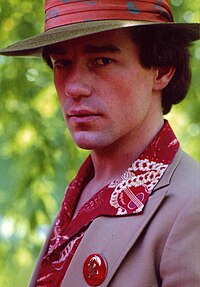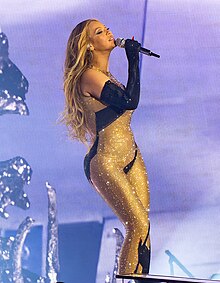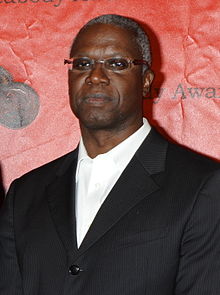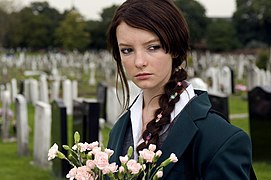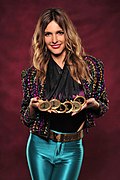Portal:Television
The Television Portal

Television (TV) is a telecommunication medium for transmitting moving images and sound. Additionally, the term can refer to a physical television set rather than the medium of transmission. Television is a mass medium for advertising, entertainment, news, and sports. The medium is capable of more than "radio broadcasting," which refers to an audio signal sent to radio receivers.
Television became available in crude experimental forms in the 1920s, but only after several years of further development was the new technology marketed to consumers. After World War II, an improved form of black-and-white television broadcasting became popular in the United Kingdom and the United States, and television sets became commonplace in homes, businesses, and institutions. During the 1950s, television was the primary medium for influencing public opinion. In the mid-1960s, color broadcasting was introduced in the U.S. and most other developed countries.
In 2013, 79% of the world's households owned a television set. The replacement of earlier cathode-ray tube (CRT) screen displays with compact, energy-efficient, flat-panel alternative technologies such as LCDs (both fluorescent-backlit and LED), OLED displays, and plasma displays was a hardware revolution that began with computer monitors in the late 1990s. Most television sets sold in the 2000s were still CRT, it was only in early 2010s that flat-screen TVs decisively overtook CRT. Major manufacturers announced the discontinuation of CRT, Digital Light Processing (DLP), plasma, and even fluorescent-backlit LCDs by the mid-2010s. LEDs are being gradually replaced by OLEDs. Also, major manufacturers have started increasingly producing smart TVs in the mid-2010s. Smart TVs with integrated Internet and Web 2.0 functions became the dominant form of television by the late 2010s.[better source needed] (Full article...)
Selected article -
Selected image -

The Emmy Award is an American television production award, similar in nature to the Peabody Awards but more focused on entertainment, and is considered the TV equivalent of the Oscars. The best-known of the awards are the Primetime Emmys, and the Daytime Emmy Awards, with both having categories classified as Creative Arts Emmys.
Did you know (auto-generated) -

- ... that the sentencing phase of the Jemma Mitchell case was the second to be filmed in England and Wales since a change in the law permitted television cameras into court?
- ... that Colin Mackay, the political editor at Scottish Television, was "very sad" when Colin MacKay, the political editor at Scottish Television, died?
- ... that former CIA agent Bazzel Baz was hired to be a consultant for The Blacklist television series and instead became a cast member?
- ... that Uncle Waffles learned how to DJ during the COVID-19 lockdowns, and then retired from being an Eswatini TV presenter once her music career took off?
- ... that William, Prince of Wales, inspired the character of Prince Wheeliam in Cars 2?
- ... that the unlicensed Willy's Chocolate Experience in Scotland led to a crossover event between the American television series Abbott Elementary and It's Always Sunny in Philadelphia?
Selected quote -
More did you know
- ...that the title of Dan Castellaneta's album of comedy sketches I Am Not Homer is a parody of Leonard Nimoy's first autobiography I Am Not Spock?
- ...that despite British Conservative MP Denis Keegan winning a marginal constituency by over 7,000 votes, he ended his political career after one term, preferring to work for the trade association for television shops?
- ...that the participants of the Channel 4 programme Dumped were not told that they would be living on a landfill site for three weeks?
- ..that the time traveling premise featured in the Chrono series of video games was inspired by such television programs as The Time Tunnel?
- ...that the Zambian district of Chiengi has no television or telephone service?
Selected biography -
Daniel Louis Castellaneta (/ˌkæstələˈnɛtə/ KAST-ə-lə-NET-ə; born October 29, 1957) is an American actor and writer. He is best known for voicing Homer Simpson on the animated series The Simpsons (as well as other characters on the show such as Grampa Simpson, Krusty the Clown, Groundskeeper Willie, Mayor Quimby, Sideshow Mel, Mr. Teeny, Santa's Little Helper, Itchy, and Barney Gumble). Castellaneta is also known for voicing Grandpa in Nickelodeon's Hey Arnold!, and has had voice roles in several other programs, including Futurama, Sibs, Darkwing Duck, The Adventures of Dynamo Duck, The Batman, Back to the Future: The Animated Series, Aladdin, Earthworm Jim, and Taz-Mania.
In 1999, he appeared in the Christmas special Olive, the Other Reindeer and won an Annie Award for his portrayal of the Postman. Castellaneta released a comedy album I Am Not Homer, and wrote and starred in a one-person show titled Where Did Vincent van Gogh? (Full article...)
General images
News
- December 28: US professional wrestler Jon Huber dies aged 41
- September 2: Tributes paid to recently deceased US actor Chadwick Boseman
- May 24: Japanese professional wrestler and Netflix star Hana Kimura dies aged 22
- January 16: BBC newsreader Alagiah to undergo treatment for bowel cancer
- Upcoming events
Featured content
Main topics
History of television: Early television stations • Geographical usage of television • Golden Age of Television • List of experimental television stations • List of years in television • Mechanical television • Social aspects of television • Television systems before 1940 • Timeline of the introduction of television in countries • Timeline of the introduction of color television in countries
Inventors and pioneers: John Logie Baird • Alan Blumlein • Walter Bruch • Alan Archibald Campbell-Swinton • Allen B. DuMont • Philo Taylor Farnsworth • Charles Francis Jenkins • Boris Grabovsky • Paul Gottlieb Nipkow • Constantin Perskyi • Boris Rosing • David Sarnoff • Kálmán Tihanyi • Vladimir Zworykin
Technology: Comparison of display technology • Digital television • Liquid crystal display television • Large-screen television technology • Technology of television
Terms: Broadcast television systems • Composite monitor • HDTV • Liquid crystal display television • PAL • Picture-in-picture • Pay-per-view • Plasma display • NICAM • NTSC • SECAM
Categories
WikiProjects

|
You are invited to participate in WikiProject Television, a WikiProject dedicated to developing and improving articles about Television. |
- Main projects
- Sub-projects
Television Stations • American animation • American television • Australian television • British TV • BBC • Canadian TV shows • Television Game Shows • ITC Entertainment Productions • Digimon • Buffyverse • Doctor Who • Degrassi • EastEnders • Episode coverage • Firefly • Futurama • Grey's Anatomy • Indian television • Lost • Nickelodeon • The O.C. • Professional Wrestling • Reality TV • The Simpsons • Seinfeld • South Park • Stargate • Star Trek • Star Wars • Soap operas • Avatar: The Last Airbender • House
- Related projects
Animation • Anime and manga • Comedy • Comics • Fictional characters • Film • Media franchises
What are WikiProjects?
Things you can do

- Place the {{WikiProject Television}} project banner on the talk pages of all articles within the scope of the project.
- Write: Possible Possum
- Cleanup: color television, Alien Nation: Body and Soul, The Sopranos, Alien Nation: Dark Horizon, Alien Nation: The Enemy Within, Alien Nation: Millennium, Aang
- Expand: Timeline of the introduction of color television in countries
- Stubs: Flow (television), Just for Kicks (TV series), Play of the Month, Nova (Dutch TV series), More stubs...
Subportals
Related portals
Associated Wikimedia
The following Wikimedia Foundation sister projects provide more on this subject:
-
Commons
Free media repository -
Wikibooks
Free textbooks and manuals -
Wikidata
Free knowledge base -
Wikinews
Free-content news -
Wikiquote
Collection of quotations -
Wikisource
Free-content library -
Wikiversity
Free learning tools -
Wiktionary
Dictionary and thesaurus






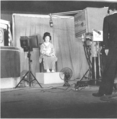




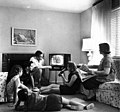















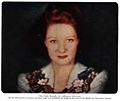
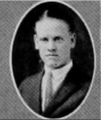
![Image 1 Millennium is a crime-thriller television series which was broadcast from 1996 to 1999. Created by Chris Carter, the series aired on Fox for three seasons with a total of sixty-seven episodes. It starred Lance Henriksen, Megan Gallagher, Klea Scott and Brittany Tiplady. Henriksen played Frank Black, an offender profiler for the Millennium Group (a private investigative organisation). Black retires from the Federal Bureau of Investigation and moves his wife Catherine (Gallagher) and daughter Jordan (Tiplady) to Seattle, where he begins consulting on criminal cases for the group. After the group's attempt to cause an apocalyptic viral outbreak kills his wife, Black returns to the FBI to work with new partner Emma Hollis (Scott) to discredit the group. Black was one of the first elements conceived for the series, the remainder of which were fleshed out by Carter around his character. Black has been described by a producer as Millennium's constant, as the series' tone and direction changed around him with each successive season. Except for Frank Black, the series' characters have been criticized as one-dimensional, "generic" and little more than "symbol[s]". Television critic Robert Shearman said that the series featured "half a dozen actors who could be termed regulars [...] but without exception they remain functional ciphers". (Full article...)](http://up.wiki.x.io/wikipedia/en/d/d2/Blank.png)

